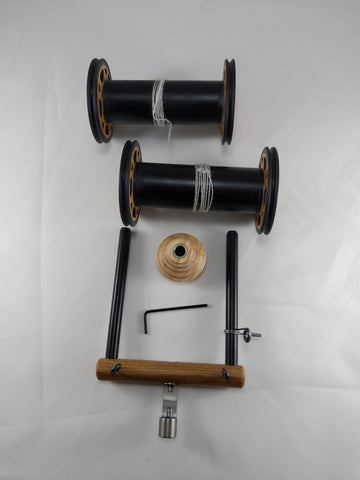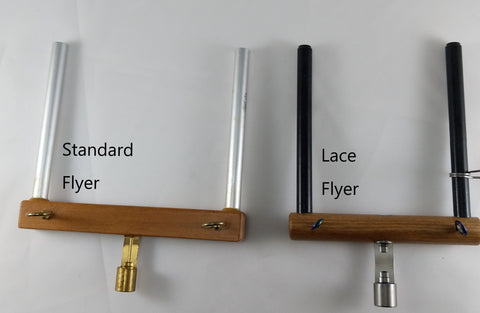I love learning new spinning techniques from an instructor vs. reading or watching videos. Don't get me wrong, I use all three methods for learning, but love the opportunity to listen, ask questions and verify understanding with a live person.
I installed a Majacraft Lace kit to my Rose spinning wheel and began using it to spin a finer lace weight yarn. These are available in my shop to purchase and can be installed on any Majacraft wheel - link to listing
Majacraft lace Kit includes two fat core bobbins, lace flyer, high speed whorl and an allen wrench.

I created one small skein then decided to reach out to one of my customers who bought a Rose and a lace kit from my shop in order to find out what I could do to get my yarn as fine as possible. She generously shared her knowledge with me, and I am happy to document in this post some of the kernels of insight that I learned from the talk.
To follow are some of my questions I had and her responses. I have also embedded the video of my interview with Caroline at the end of this blog post.
What is a lace weight yarn?
Lace weight is any yarn that yields 18 wraps per inch (WPI) on a standard yarn gage. You measure it by wrapping your yarn around the gage and count the strands that fall within a notch in the gauge which is premeasured so you can calculate how many wraps would fit within one inch.
My Yarn Gage has a groove that is 1/2 inch, so this yarn is 30 WPI:

A higher number indicates a finer yarn. 18 WPI is the lowest gage to qualify as lace weight. Lace weight has other names, some are slang like frog hair, others have more acceptance as descriptions of gage, like "cobweb" for example. 3 fiber strands are the minimum to be called "yarn", and that is really fine!
What are the basic materials needed to make a lace weight yarn?
The most important thing is to use a very fine wool. The neck wool is typically the finest wool on the body, but if you have wool that microns around 20, with a low standard deviation, you are using a good material for lace weight yarn. Our soft shetland sheep usually micron in the low 20's, so I think I am in good shape for material requirements for spinning lace.

What tools are used to make a lace weight yarn?
Majacraft makes a lace kit which has some features that make it easier to create a fine yarn. First of all the flyer has a very short bar. This reduces the distance the yarn needs to travel as it's winding on the bobbin which reduces the risk of breakage due to the fine nature of the yarn.

The bobbins in the lace kit flanges are smaller so they can fit inside the lace flyer. They also have an enlarged core which reduces the tension of the takeup, again allowing you to apply more twist to the yarn for a stronger, but finer strand.

The whorl that is supplied with the lace kit takes you to higher ratios which result in a very fast rotation of the flyer, incorporating much more twist than you would get with a standard whorl. My wheel is a Rose, so I am showing the whorl from my wheel compared to the lace kit fast speed whorl.

When you spin thicker yarns you have the benefit of many strands in your twist which provides strength to the ply. This is less the case with lace yarns. So Majacraft has tailored the parts of the wheel which when combined create the optimal conditions for spinning lace yarns, which are as follows:
- Light takeup tension to prevent breakage and allow for more twist before winding on bobbin
- Shorter distance between flyer bar and bobbin core
- Faster flyer rotation to get more twist into the yarn
What techniques are used to make a lace weight yarn?
When I started out with the lace kit I was using a supported long draw drafting technique. After talking with Caroline I decided to switch over to short forward draw. Spinning as a worsted yarn with as few fibers as possible is how you create the finest yarn.
Because you are consciously trying to minimize the number of fibers that go into your yarn, it is a good idea to put a cloth behind your spin so you can easily see how many fibers you are introducing into your twist.
If you are spinning from roving or combed top, you want to isolate some fibers to measure their length so you have an idea of the optimal length of your drafting zone.
Caroline showed me a few very lightweight spindles that she uses for lace spinning which is another way to achieve fine yarn. She shared the links to those suppliers:
Trillium spindle from Bull Sheep Fibery
SpindleLady has some very lightweight spindles
There is a contest for lace spinning called "The Longest Thread Competition". Can you tell us about it?
The contest is in Tazmania, Australia and takes place every other year. The next competition is in March 2021, entries from the states should have beenin the mail by the end of October to arrive in time for the entry deadline. The challenge is to spin the longest 2 ply yarn with 10 grams of fiber (1/3 oz). The judges measure the length of all the entries in the different classes, and the longest strand wins. The record for wool is 1,442 yards held by Naoko Tamuro from the 2005 competition.
Bothwell Spin in - Longest Thread Contest
What do you do with lace weight yarn?
Lace weight yarn can be used for knitting shawls, weaving and crocheting lace items. Caroline talked about how to use lace weight for weaving.
I am currently in the process of working towards a very fine lace yarn and will share my progress and findings in my next blog post!


No comments:
Post a Comment